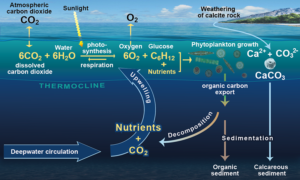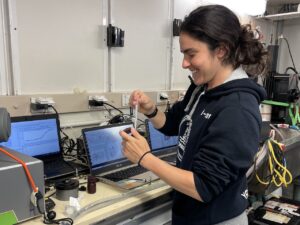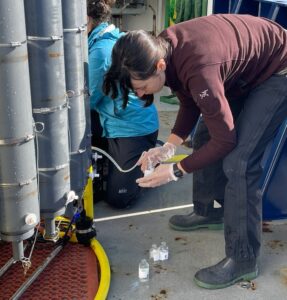Saturday, June 03, 2023 – Offshore North Pacific Coast (Latitude: 42.50.801 N, Longitude: 124.40.196 W)
The Chemistry of Life

Phytoplankton play a key role in our atmosphere providing half of the oxygen we need to sustain life. Like land plants, these ocean microbes rely on sunlight, water, and nutrients to support photosynthesis. Nutrients are readily available to land plants within their environment and even have humans to assist with additional nutrients if needed. Phytoplankton rely on sunlight at the surface and upwelling currents from the deep ocean to bring nutrients to the surface. Photosynthesis in the ocean requires unique adaptations that allow the microbes to flourish in times of feast (e.g. upwelling) and to survive in times of famine when downwelling currents persist and nutrients at the surface are depleted. Light absorption is vital for photosynthesis and, like land plants, chlorophyll is the primary pigment used by phytoplankton to absorb light during photosynthesis. Different species of plankton have unique light-absorbing pigments that assist them in photosynthesis. Sacchi Pillai, from UBC (University of British Columbia) is measuring these unique light absorption pigments to observe how the different communities of phytoplankton change as the upwelling bloom ages.

Yayla Sezginer (UBC) is focusing on the physiology of the phytoplankton and the efficiency of photosynthesis. She will quantify the rates of Carbon dioxide absorption and Oxygen release by the microbes throughout the duration of the bloom. Her data will help her determine the phytoplankton’s photosynthesis efficiency from the start of the bloom to the end of the bloom when the nutrients have been depleted.

Most of us are familiar with Carbon dioxide (CO2) as a greenhouse gas and its warming impacts to the future of our planet. However, CO2 as a greenhouse gas is not working alone. Kate’s research focuses on two other greenhouse gases that have the potential to impact Earth’s changing atmosphere.

Nitrous oxide (N2O) and Methane (CH4) are two additional contributors to greenhouse gases. One molecule of N2O traps 300 times more heat than a molecule of CO2. By the same comparison, Methane traps 100 times more heat than Carbon dioxide though the atmosphere holds onto the carbon dioxide longer (i.e., centuries) than methane (i.e., decade).2 Kate Schuler (UBC) is measuring the amount of nitrous oxide and methane being produced and released during the phytoplankton bloom to gain a better understanding of how the gases being exchanged during a coastal upwelling event will affect our atmosphere.
1 Flores, Kevin. Professor Awarded Grant for NASA Research. Daily Nexus. University of California. Santa Barbara, CA. June 02, 2023. https://dailynexus.com/2016-04-21/professor-awarded-grant-for-nasa-research/ (Courtesy: rapid.ac.uk).
2 Moseman, Andrew. Why do we compare methane to carbon dioxide over a 100-year timeframe? Are we underrating the importance of methane emissions? Climate Portal. Massachusetts Institute of Technology. Cambridge, MA. June 28, 2021. https://climate.mit.edu/ask-mit/why-do-we-compare-methane-carbon-dioxide-over-100-year-timeframe-are-we-underrating.
